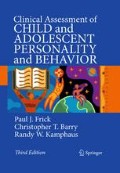Abstract
Users of instruments assessing personality and other aspects of behavioral, emotional, and social functioning should have a thorough understanding of measurement principles. The discussion that follows, however, hardly qualifies as thorough because measurement instruction is not the purpose of this book. This chapter merely points out some of the most important measurement concepts for conducting assessments of youth.
We assume that the user of this text has had, at a minimum, undergraduate courses in statistics, tests and measurements, as well as at least one graduate-level measurement course. If a user of this text is not acquainted with some of the principles discussed here, then a statistics and/or measurement textbook should be consulted. There are a number of excellent measurement textbooks available, including Anastasi and Urbina (1998) as well as Allen and Yen (1979). The reader is also referred to the Code of Fair Testing Practices in Education (Joint Committee on Testing Practices, 2004) for a discussion of the appropriate procedures for test development, test selection, scoring, interpretation, and communication of results.
Access this chapter
Tax calculation will be finalised at checkout
Purchases are for personal use only
Notes
- 1.
When orthogonal (independent or uncorrelated) rotation techniques are used (and these techniques are very frequently used in test validation research), the factor loading represents the correlation between the subtest and a factor. This is not the case when oblique or correlated methods of factor analysis are used (Anastasi & Urbina, 1998).
Author information
Authors and Affiliations
Corresponding author
Rights and permissions
Copyright information
© 2009 Springer Science+Business Media, LLC
About this chapter
Cite this chapter
Frick, P.J., Barry, C.T., Kamphaus, R.W. (2009). Measurement Issues. In: Clinical Assessment of Child and Adolescent Personality and Behavior. Springer, Boston, MA. https://doi.org/10.1007/978-1-4419-0641-0_2
Download citation
DOI: https://doi.org/10.1007/978-1-4419-0641-0_2
Published:
Publisher Name: Springer, Boston, MA
Print ISBN: 978-0-387-89642-7
Online ISBN: 978-1-4419-0641-0
eBook Packages: Behavioral ScienceBehavioral Science and Psychology (R0)

